Related Research Articles

Orangutans are great apes native to the rainforests of Indonesia and Malaysia. They are now found only in parts of Borneo and Sumatra, but during the Pleistocene they ranged throughout Southeast Asia and South China. Classified in the genus Pongo, orangutans were originally considered to be one species. From 1996, they were divided into two species: the Bornean orangutan and the Sumatran orangutan. A third species, the Tapanuli orangutan, was identified definitively in 2017. The orangutans are the only surviving species of the subfamily Ponginae, which diverged genetically from the other hominids between 19.3 and 15.7 million years ago.

Primates are a diverse order of mammals. They are divided into the strepsirrhines, which include the lemurs, galagos, and lorisids, and the haplorhines, which include the tarsiers and the simians. Primates arose 85–55 million years ago first from small terrestrial mammals, which adapted to living in the trees of tropical forests: many primate characteristics represent adaptations to life in this challenging environment, including large brains, visual acuity, color vision, a shoulder girdle allowing a large degree of movement in the shoulder joint, and dextrous hands. Primates range in size from Madame Berthe's mouse lemur, which weighs 30 g (1 oz), to the eastern gorilla, weighing over 200 kg (440 lb). There are 376–522 species of living primates, depending on which classification is used. New primate species continue to be discovered: over 25 species were described in the 2000s, 36 in the 2010s, and three in the 2020s.

Perth Zoo is a 17-hectare (41-acre) zoological park in South Perth, Western Australia. The zoo first opened in 1898 and by 2011 housed 1258 animals of 164 species and an extensive botanical collection. It is a full institutional member of the Zoo and Aquarium Association (ZAA) and the World Association of Zoos and Aquariums (WAZA).
Research into great ape language has involved teaching chimpanzees, bonobos, gorillas and orangutans to communicate with humans and with each other using sign language, physical tokens, lexigrams, and mimicking human speech. Some primatologists argue that these primates' use of the communication tools indicates their ability to use "language", although this is not consistent with some definitions of that term.
Chantek, born at the Yerkes National Primate Research Center in Atlanta, Georgia, was a male hybrid Sumatran/Bornean orangutan who mastered the use of a number of intellectual skills, including American Sign Language (ASL), taught by American anthropologists Lyn Miles and Ann Southcombe. In Malay and Indonesian, cantik means "lovely" or "beautiful".
Human–animal communication is the communication observed between humans and other animals, ranging from non-verbal cues and vocalizations to the use of language.

The Sumatran orangutan is one of the three species of orangutans. Critically Endangered, and found only in the north of the Indonesian island of Sumatra, it is rarer than the Bornean orangutan but more common than the recently identified Tapanuli orangutan, also found in Sumatra. Its common name is based on two separate local words, "orang" and "hutan" ("forest"), derived from Malay, and translates as 'person of the forest'.

Ah Meng was a female Sumatran orangutan and a tourism icon of Singapore. She was smuggled from Indonesia and kept illegally as a domestic pet before being recovered by a veterinarian in 1971. She was then eleven years old and was given a home at the Singapore Zoo.
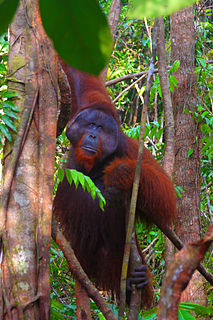
The Bornean orangutan is a species of orangutan endemic to the island of Borneo. Together with the Sumatran orangutan and Tapanuli orangutan, it belongs to the only genus of great apes native to Asia. Like the other great apes, orangutans are highly intelligent, displaying tool use and distinct cultural patterns in the wild. Orangutans share approximately 97% of their DNA with humans.
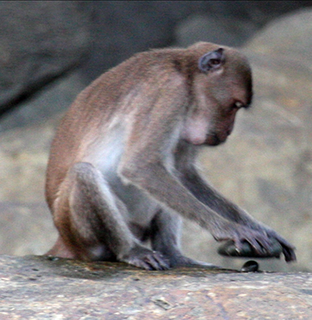
Tool use by animals is a phenomenon in which an animal uses any kind of tool in order to achieve a goal such as acquiring food and water, grooming, defense, communication, recreation or construction. Originally thought to be a skill possessed only by humans, some tool use requires a sophisticated level of cognition. There is considerable discussion about the definition of what constitutes a tool and therefore which behaviours can be considered true examples of tool use. A wide range of animals, including mammals, birds, fish, cephalopods, and insects, are considered to use tools.
A talking animal or speaking animal is any non-human animal that can produce sounds or gestures resembling those of a human language. Several species or groups of animals have developed forms of communication which superficially resemble verbal language, however, these usually are not considered a language because they lack one or more of the defining characteristics, e.g. grammar, syntax, recursion, and displacement. Researchers have been successful in teaching some animals to make gestures similar to sign language, although whether this should be considered a language has been disputed.
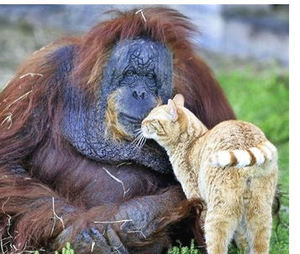
Tonda,, was the oldest orangutan in the United States. Tonda died on March 23, 2009, at ZooWorld in Panama City Beach, Florida, aged 50.

Nest-building in primates refers to the behaviour of building nests by extant strepsirrhines and hominid apes. Strepsirrhines build nests for both sleeping and raising families. Hominid apes build nests for sleeping at night, and in some species, for sleeping during the day. Nest-building by hominid apes is learned by infants watching the mother and others in the group, and is considered tool use rather than animal architecture. Old World monkeys and New World monkeys do not nest. It has been speculated that a major evolutionary advance in the cognitive abilities of hominoids may first have occurred due to the development of nest-building behaviour and that the transition from nest-building to ground-sleeping led to "modifications in the quality and quantity of hominid sleep, which in turn may have enhanced waking survival skills through priming, promoted creativity and innovation, and aided the consolidation of procedural memories".

Non-reproductive sexual behavior consists of sexual activities animals participate in that do not lead to the reproduction of the species. Although procreation continues to be the primary explanation for sexual behavior in animals, recent observations on animal behavior have given alternative reasons for the engagement in sexual activities by animals. Animals have been observed to engage in sex for social interaction bonding, exchange for significant materials, affection, mentorship pairings, sexual enjoyment, or as demonstration of social rank. Observed non-procreative sexual activities include non-copulatory mounting, oral sex, genital stimulation, anal stimulation, interspecies mating, and acts of affection, although it is doubted that they have done this since the beginning of their existence. There have also been observations of sex with cub participants, same-sex sexual interaction, as well as sex with dead animals.
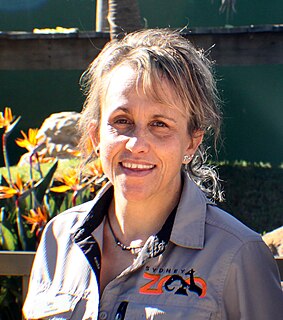
Louise (Lou) Grossfeldt is a zoo keeper, primate husbandry specialist and conservationist, based in Australia. For over 20 years, she worked with primates at Sydney's Taronga Zoo. In 2015, Lou commenced work as a curator at Mogo Zoo on the New South Wales South Coast. In 2017 she became Mogo Zoo's Manager Life Sciences. In January 2019, she was appointed as the Manager of Primates at Sydney Zoo in Western Sydney.
The Sumatran Orangutan Conservation Programme (SOCP) is a collaborative project involving Indonesian NGO Yayasan Ekosistem Lestari (YEL) - as the main implementer in Indonesia, its Swiss partner the PanEco Foundation, and the Indonesian Ministry of Environment and Forestry’s Directorate General of Natural Resource and Ecosystem Conservation, under several Memoranda of Understanding (MoU) starting in 1999.
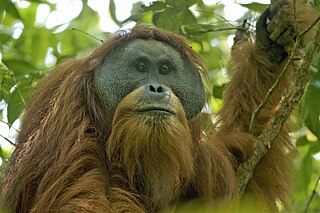
The Tapanuli orangutan is a species of orangutan restricted to South Tapanuli in the island of Sumatra in Indonesia. It is one of three known species of orangutan, alongside the Sumatran orangutan, found farther northwest on the island, and the Bornean orangutan. It was described as a distinct species in 2017. As of 2018, there are roughly 800 individuals of this species and it is currently on the critically endangered species list.
Melanie R. Bond is a biologist, primate scientist and author. She was the first woman to serve as a gorilla keeper at the National Zoo in Washington, D.C. She authored and co-authored several books on primates and animal keeping, including the Orangutan (Pongo) Care Manual for the Association of Zoos & Aquariums.

In 1964 there was an outbreak of monkeypox at Rotterdam Zoo, where two Central/South American giant anteaters were first identified with the disease. Until then, monkeypox was thought to occur only in primates. Housed in one large enclosure, the monkeypox virus subsequently spread to several orangutans, chimpanzees, gorillas, guenons, squirrel monkeys, macaques, marmosets and gibbons.
References
- ↑ "Orangutan". Smithsonian's National Zoo. 2016-06-06. Retrieved 2016-11-05.
- ↑ Wich, S. A.; Swartz, K. B.; Hardus, M. E.; Lameira, A. R.; Stromberg, E.; Shumaker, R. W. (2008). "A case of spontaneous acquisition of a human sound by an orangutan". Primates. 50 (1): 56–64. doi:10.1007/s10329-008-0117-y. PMID 19052691. S2CID 708682.